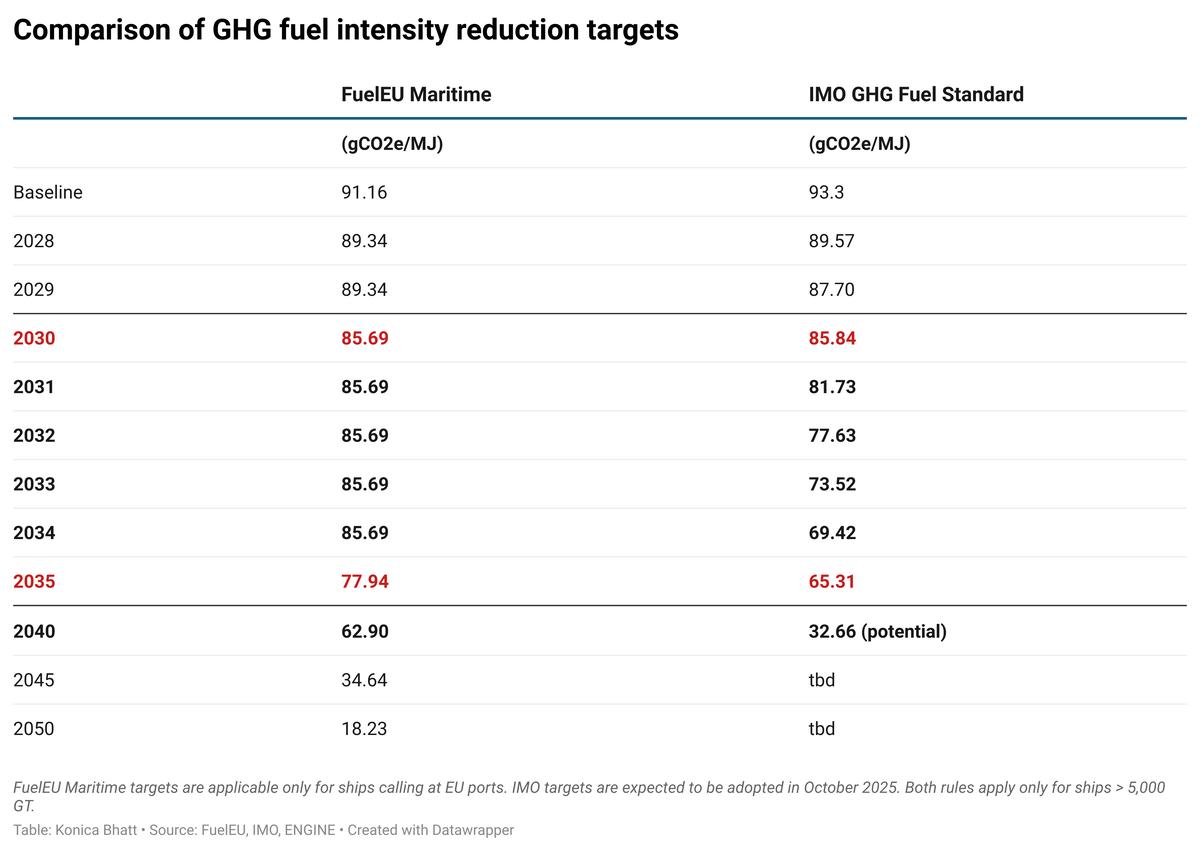The Week in Alt Fuels: One ship, two rules
Ships sailing to EU ports could face a regulatory undertow from 2028, as mismatched IMO and EU targets create a double compliance burden.

In a recent webinar hosted by the Global Maritime Forum (GMF), energy expert Jeroen Dierickx asked whether ships running on fossil fuels in the EU will be penalised under both the IMO and EU systems once the global framework kicks in.
“Yes, ships with EU exposure will have to pay for the separate systems,” confirmed GMF project manager Femke Spiegelenberg.
This question brings the conversation back to a moment that now seems almost prophetic.
In March 2024, ENGINE asked IMO Secretary-General Arsenio Dominguez whether shipowners were heading into a decade of fragmented compliance if regional and global rules failed to align.
“I would always continue to call for global regulations for a global sector. And I have been very open, including with the European Union, the European Commission, that I expect that we will only end up with one global regulation,” Dominguez had told ENGINE.
At the time, the EU's FuelEU Maritime regulation was not yet in force and the IMO’s mid-term measures were still being debated and developed behind closed doors.
But signs of tension were already emerging. Shipowners were preparing to grapple with the complexities of the EU’s technical rules, while the prospect of global rules on top of the EU's risked further complicating operations, financing and fuel planning.
Fast forward to April 2025, and those concerns have become more pressing. The crux of the problem lies in misaligned regional and global GHG reduction targets.
The IMO’s approved framework will cap the GHG intensity of energy used onboard ships at 65.31 grams of carbon dioxide-equivalent per megajoule (gCO2e/MJ) by 2035, using 2008 levels as its baseline.
FuelEU Maritime sets a softer target of 77.94 gCO2e/MJ by the same year and benchmarks against 2020 levels.
The IMO imposes a fee for non-compliance but stops short of a carbon price, The EU’s Emissions Trading System (EU ETS) places a direct cost on emissions.
Their approaches also diverge in incentivising low- and zero-emission fuel uptake and allocating revenues, GMF’s Spiegelenberg pointed out.
And the result? A potential double compliance for shipowners with EU-linked voyages.
For instance, a ship operating entirely on fossil fuel in the EU from 2028 will need to pay EU ETS costs, FuelEU Maritime non-compliance fees as well as penalties for failing to meet the IMO’s global targets.
Some fuel producers and shipping companies are now questioning the consequences of this fragmented landscape.
European fuel industry trade body FuelsEurope said the IMO’s framework offers predictability, but its lack of alignment with EU rules could shake investor confidence.
"Regulatory stability and predictability are essential to unlock the long-term and capital-intensive investments required to support the transition," the group said, adding that consistency with the EU’s approach will be “crucial.”
Since the IMO has no carbon price, the EU ETS is expected to remain within the EU’s regulatory framework, Silva Hoffmann, EU policy analyst at Höegh Autoliners said. But she questions what will happen to the excess penalties paid under FuelEU Maritime, and whether the IMO plans to address this concern in later meetings.
ETFuels' chief technology officer Anthony Wang pointed to the operational impact: “A lot of customers are now aligned with FuelEU Maritime targets, and now they have to align with the IMO too,” he said.
Wang argues that it will be difficult for the European Commission to justify tightening its targets now, given the current uncertainty around the IMO’s reward structures.
While IMO Secretary-General Dominguez reiterated last year that the EU should align with a global regime, it could be politically difficult for the EU to amend a legislation already in force.
For now, ships calling at EU ports are expected to face a multi-layered compliance structure beyond 2028, one that may not ease unless both regulatory camps find common ground.
In other news this week, engine manufacturer Japan Engine Corporation (J-ENG) plans to deliver its first ammonia dual-fuel engine to a shipyard by October. The engine is currently undergoing co-firing tests. Once testing is complete, the engine will be installed on a gas carrier newbuilding for pilot tests.
Japanese gas supplier Osaka Gas started terminal-to-ship LNG bunkering at its Senboku LNG Terminal in the Port of Sakai-Semboku, located in Japan's Osaka Bay. The first stem was delivered to the Verde Heraldo, a dual-fuel bulk carrier operated by Mitsui O.S.K. Lines.
South Korean shipbuilder HD Hyundai Mipo (HD HMD) received an order from an unnamed shipping company to build two LPG dual-fuel gas carriers. Each vessel will have a capacity of 45,000-cbm and will be capable of operating on both LPG and conventional marine fuels. Delivery is scheduled for July 2027.
By Konica Bhatt
Please get in touch with comments or additional info to news@engine.online





